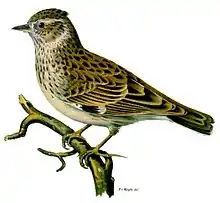| Lullula | |
|---|---|
 | |
| Scientific classification | |
| Domain: | Eukaryota |
| Kingdom: | Animalia |
| Phylum: | Chordata |
| Class: | Aves |
| Order: | Passeriformes |
| Family: | Alaudidae |
| Genus: | Lullula Kaup, 1829 |
| Species | |
|
see text | |
Lullula is the genus of woodlarks, songbirds in the family Alaudidae. There is only one remaining extant species, the woodlark which is found in Europe, the mountains of northern Africa, the Middle East and western Asia. The remainder are known only from the fossil record.
Taxonomy and systematics
The genus Lullula was introduced by the German naturalist Johann Jakob Kaup in 1829.[1] The genus Lullula is onomatopoeic from the French Lulu, the name given by de Buffon. Both the French name, Alouette lulu and the genus name are derived from the sound of its song.[2]
The genus contain a single extant species, the woodlark (Lullula arborea).[3]
Extinct species
- †Lullula balcanica - late Pliocene of Varshets, Bulgaria[4]
- †Lullula slivnicensis - late Pliocene of Slivnitsa, Bulgaria[4]
- †Lullula minor - late Miocene of Polgardi, Hungary[5]
- †Lullula parva - Pliocene of Csarnota, Hungary[5]
- †Lullula minuscula - Pliocene of Beremend, Hungary[5]
- †Lullula neogradensis - Miocene of Mátraszőlős, Hungary[6]
References
- ↑ Kaup, Johann Jakob (1829). Skizzirte Entwickelungs-Geschichte und natürliches System der europäischen Thierwelt (in German). Vol. c. 1. Darmstadt: Carl Wilhelm Leske. p. 92.
- ↑ Campbell, Donald (1999). The Encyclopedia of British Birds. Bath: Paragon. p. 165. ISBN 9780752541594.
- ↑ Gill, Frank; Donsker, David, eds. (2018). "Nicators, reedling, larks". World Bird List Version 8.2. International Ornithologists' Union. Retrieved 15 July 2018.
- 1 2 Boev, Z. 2012. Neogene Larks (Aves: Alaudidae (Vigors, 1825)) from Bulgaria - Acta zoologica bulgarica, 64 (3), 2012: 295-318.
- 1 2 3 Kessler, E. 2013. Neogene songbirds (Aves, Passeriformes) from Hungary. – Hantkeniana, Budapest, 2013, 8: 37-149.
- ↑ Kessler, Jeno; Hir, Janos (2012). "The avifauna in North Hungary during the Miocene Part II" (PDF). Hungarian Geological Society. 142/2: 149–168.
This article is issued from Wikipedia. The text is licensed under Creative Commons - Attribution - Sharealike. Additional terms may apply for the media files.